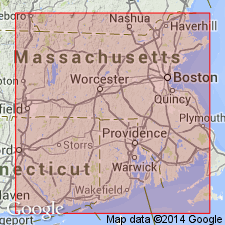
- Usage in publication:
-
- Narragansett Plutonic Suite
- Modifications:
-
- Named
- Dominant lithology:
-
- Granite
- AAPG geologic province:
-
- New England province
Summary:
Narragansett Plutonic Suite consists of Narragansett Pier Granite and Westerly Granite, which occur in both the Hope Valley and Esmond-Dedham terranes (the Avalon Superterrane of this report). Outcrops trend East-West along the coasts of RI and CT. Similar rocks also recognized in southeastern MA. According to Zartman and Hermes (1987), the granites are essentially coeval. The Westerly, though dated at 276+/-7 Ma (U/Pb), may slightly postdate the Narragansett Pier (U/Pb 273+/-2 Ma) based on apparent intrusive contacts. [Intent to name is not clearly stated, but inferred from the following statement in table 1: "On the basis that these lithodemes are geologically associated and have been determined to be essentially coeval, it is appropriate for them to be ranked as a suite (North American Stratigraphic Code, 1983)." Name appears as Narragansett Pier Plutonic Suite in fig. 1, but this is no doubt an error.]
Source: GNU records (USGS DDS-6; Reston GNULEX).
For more information, please contact Nancy Stamm, Geologic Names Committee Secretary.
Asterisk (*) indicates published by U.S. Geological Survey authors.
"No current usage" (†) implies that a name has been abandoned or has fallen into disuse. Former usage and, if known, replacement name given in parentheses ( ).
Slash (/) indicates name conflicts with nomenclatural guidelines (CSN, 1933; ACSN, 1961, 1970; NACSN, 1983, 2005, 2021). May be explained within brackets ([ ]).

